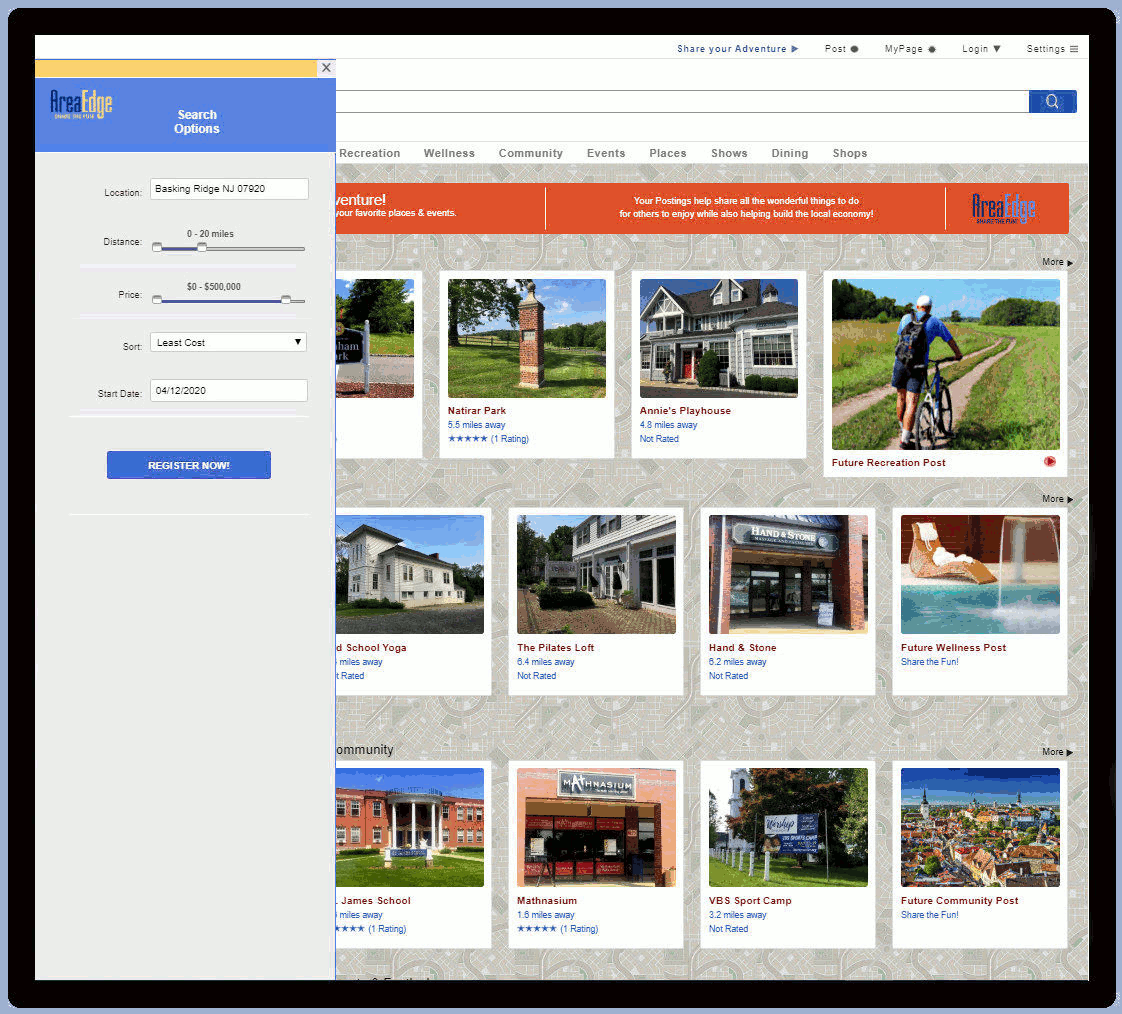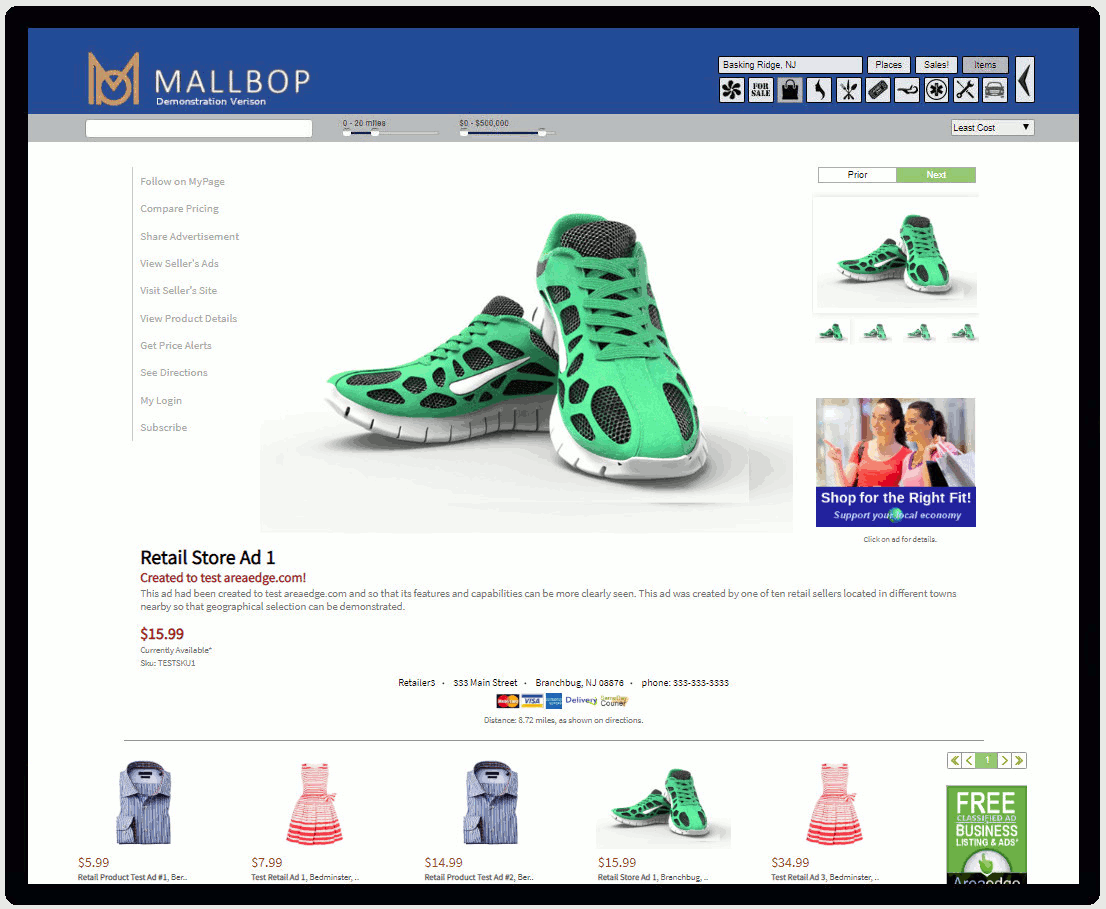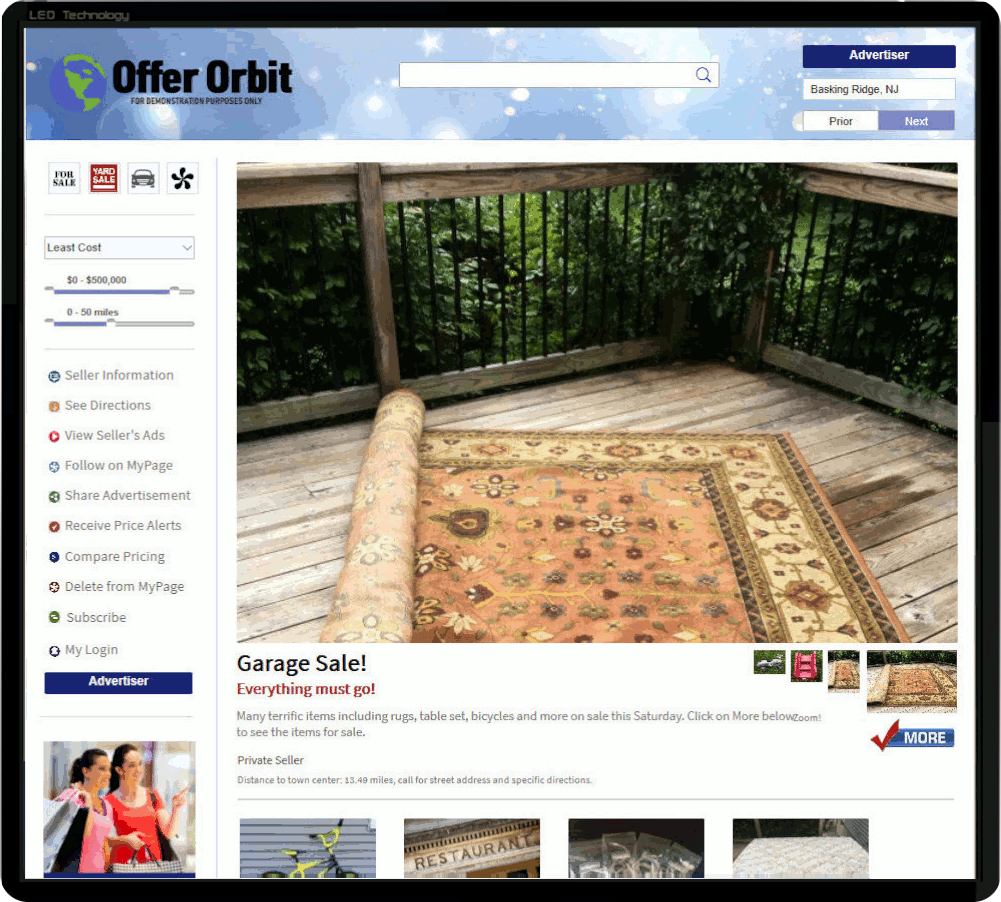



SHARE THE FUN!
What’s there to do today? Regardless of all of the individual marketing efforts, sites and services, most consumers have tremendous difficulty answering this very question. Areaedge helps contributors share events and places worth visiting, so each of can wake up confident knowing just what to do today.
Areaedge is Thinkstar’s first social media project and it represents the culmination of our technological skills. Though structurally different, it builds upon and advances the core technology offered in Mallbop and it is our most commercial-ready end-end offering.
Areaedge is a proximity driven event system that displays fun “to-do" postings shared by contributors using a custom built, highly integrated posting upload content management system. By selecting dates and distances, consumers can make visible all that is happening around them.
Advertisers delight in knowing that all posts rank equally without interference from paid ads. Areaedge is first and foremost proximity driven like Mallbop, as local advertising is our top priority. Post content and pictures are found by menu item, date and price range and local proximity. Posts can be narrowed even further by selecting a category or name using the search bar -- that's a lot of ways to be found!
Further postings feature content and ratings generated by the consumer, that when combined represent a truthful perspective about the experience, place or event, and this valuable first-hand information can be used to act upon and improve user experiences everywhere.
Areaedge is hosted on a fully secure and scalable cloud environment. Funding, technical and marketing support, and legal management remains key obstacles preventing full scale market deployment.


LOCAL AND ONLINE!
If seamlessly locating goods and products locally, across retail stores and malls, sounds like the perfect local village, then you are not alone. The local retail industry is being clobbered by eCommerce giants, including Amazon and eBay. While the global retail market is reaching $25 trillion USD, its growth is not expected to pick up until 2023. Meanwhile, eCommerce sales worldwide has topped $3.5 trillion USD, and is expected to reach $6.5 billion by 2023*.
While many consumers today, are satisfied with product availability, low costs and quick delivery provided by online retail conglomerates, including Amazon and eBay, another threat exists for large retail store chains. Traditional and private label brands are increasingly bypassing retail partners and selling direct to the consumer, taking advantage of direct relationships, first party analytics, and product personalization*
Mallbop explores the local village shopping model by providing multi-key product indexing and proximity-based searches preserving the direct retailer-customer relationship. It offers stores the capacity to post their retail goods online so that they can be found outside of their website silo, while helping consumers identify products locally across retailers.
The core proposition behind Mallbop is to make local product availability transparent and equally accessible online consumers. This is important, as not only does local shopping bear key economic implications, but it also offers consumer many unique advantages, including: fit and feel, and immediate accessibility, purchase, and return. Consumers demand increasingly convenient and efficient services offered by eCommerce, but need and desire the social experience offered by shopping malls. In short, shopping Malls are not mere shops or “commercial-service facilities.” They are retail-entertainment centers of social interaction and fun (e.g. Michon, Yu, Smith, & Chebat, 2008; Uzzell, 1995)
It is Thinkstar’s assertion that the key failure of local retailers is that they have not made operational changes to leverage the online sales model. Many stores for instance, continue to have clerks focus on stocking and merchandizing, rather than incorporating online customer management into their position, shipping remains the primary delivery mechanism for goods not on display, shopping queues can be long and annoying, product inventory is often inaccurate, and the availability of goods are siloed. The core failure of not making product inventory transparent and managing online customer inquiries has not only resulted in local economic disturbances, but also promises to get worse as the online experiences and operating leverage improves.
Mallbop is a cross-store, product location system, that provides direct relationships between store and consumer. It does not manage the sale, instead it’s aim is to seamlessly handoff the sale and second party trusted partner analytics (SPTPA) to the Retailer. Mallbop also works to provide eCommerce best practices, including price searches and sale notifications. It is convenient, transparent, and unweighted; its Queries are prioritized only by proximity and location selections, not keyword advertising. The future of Mallbop is unlimited as is its user experience – mobile, phone, text, virtual reality and AI, may all be in its future.
Mallbop is available on the cloud for demonstration. It’s a fully functional model, though still requiring a wholeheartedly cross-functional effort to commercialize. Initially, Mallbop is ideally suited as a local platform that can be utilized independently at the local level, including use at shopping malls and municipalities. Derivatives of this product can satisfy online classified ad and rummage sales needs as well. See it online at mallbop.com.
*Reference: What is the Future of Ecommerce? 10 insights on the evolution of an Industry, by Nick Winkler, Jan 23, 2020).


CLASSIFIED ADSHARE!
Thinkstar believes that one highly disregarded vertical is the local classified ad space, $2.565 Billion in the U.S. alone in 2020, according to Statistica, to be exact. Classified ad service an important need for many citizens and have a worthy placeholder in the local economy. Used good sales, enable those with less to have and experience more and increases (tax-free) spending capital, while often reducing landfill.
Consumer use of classified ad portals remains limited, often preferring local circles and word of mouth to sell used goods, regardless of greater technical proficiency and readily accessible mobile cameras.
There are many keys opportunities within this vertical, including: improving upon user experineces, leveraging second party trusted partner advertising (SPTPA), developing effective API’s to embed classified ads on trusted partner sites, and better implementing “wanted” advertisement registration and pushed content.
Proximity based local classified advertising is a core capability of Mallbop, that has been strategically broken off into it’s own product, code named: OfferOrbit. While resources are required to complete this initiative, this fully featured and working model provides provides a glimpse of what can be a robust online consumer experience.
In addition to that already stated, design work has been completed to accommodate a hierarchically managed, proximity concentric. online rummage sale model. This unique vertical provides an well-needed offering to fill the needs of private and not-for-profit centers, including schools and churches.